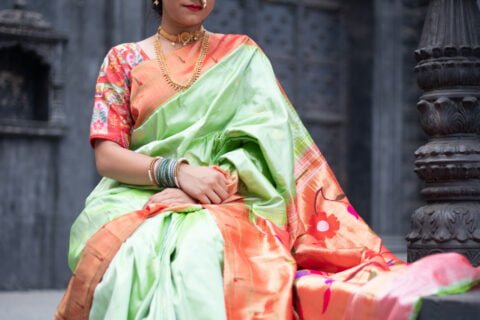
The 2000-Year Legacy of the Paithani Saree: A Hidden History
The History of Paithani Saree:
Paithani, known for its special art and tradition, has a history spanning over 2000 years. It originated in Paithan, a beautiful city that was the capital of the Satavahana Dynasty around 200 BC, located near the Godavari River. The history of paithani saree flourished with the support of the Satavahana kings.

Later it progressed throughout the Deccan region. In Paithani, they use an old method called tapestry. It involves weaving many threads of various paithani sarees colours, along with gold and silver threads, into a beautiful silk fabric.
In the distant past, The flowers & patterns on its pallu seem to float on a river of molten gold, transporting you through the flues of time to a long time ago, around 200 BC, Paithani silk saree was highly valued in a magnificent city called Pratishthan, ruled by the famous Shalivahana.
Today, Pratishthan is known as Paithan, located by the Godavari River in Marathwada, about 50 Km. from Aurangabad).
At that time, the city was a trade center for silk & zari [gold yarn] & even exported cottons & silks to the Roman Empire. The name ‘’Paithani’’ for this fabric comes from the city itself. Paithani saree was exported to many countries and was traded in exchange for gold & precious stones.
This tells us that the fabric was considered to be very precious. Because of its preciousness, the fabric & the tradition survived and supported along the way.

The Paithani Art of Weaving:
During the time of the Mughals the art of weaving this sari was encouraged & patronized by Aurangzeb, around the 17TH Century. The ‘Aurangzebi’ designs that were specially developed for him are used even today.

After the Mughals, it was the Great Peshwas who encouraged the history of paithani art. It is said that Madhavrao Peshwe had special motifs & color combinations designed exclusively for himself.
He even draped the fabric over his shoulders like a stole. Other Peshwa royalty also ensured that paithani silk saree weaving was increased. Under their patronage, even Yeola, a town near Nashik, became as important as Paithan.
The Peshwas encouraged Maharashtrians to feel proud of paithani. Gradually, the magic of the paithani silk saree slowly spread to neighboring regions & even the Nizam of Hyderabad came under its spell.
Special types of paithani designs were made to match the tastes of Paithani’s new admirers.
Despite the pressures of change, the history of paithani saree still survives, embodying the values of traditional pride, artistic dedication, indigenous culture & the eternal values of perfection.
Satavahana Dynasty on Paithani History:
The Satavahana Empire was a royal Indian dynasty based on Kotilingala as well as Junnar (Pune), and Prathisthan (Paithan) in Maharashtra. From 230 BCE onward, the empire’s territory covered much of India.
The Satavahanas are known for bringing peace to the country. Under the splendid capital of the Satavahana Dynasty in 200 BC on the banks of the divine Godavari River, the history of paithani saree grew under the patronage of the Satavahana dynasty of kings.
Later it progressed throughout the Deccan region. paithani silk saree uses an old method called tapestry. In this technique, many threads of paithani sarees colours, along with gold and silver threads, are woven together to make a beautiful silk piece.
The Yeola History of Raje Raghuji Baba:
Yeola became a wealthy community under his leadership. He was born in 1597 A.D., Raghuji Baba Patil originally hailed from Rajasthan, At age 10, he left his birthplace, Dashi in Rajasthan, and moved to Patode, a small village near Yeola.
At that time, the art of paithani saree yeola weaving was thriving in Ahmedabad and Hyderabad.

Raghuji Baba invited the artisans from these cities to come to Yeola. Not only did he offer them housing and a place for their craft, near the citadel, but he also gave them capital to help launch their business.
The craftsmen worked day and night until the village of Yeola started producing paithani. The yeola paithani saree along with other material/cloth was traded all over the country and also exported to foreign lands. Raghuji Patil patronized all religious sects.



